Gravy-Making 101
Gravy is generally defined as a sauce made from meat juices, often combined with broth or milk, and thickened with a starch. It can also be the reduced juices left from cooking proteins such as meat, fish or poultry. Although fairly simple to make, the whole idea tends to scare a lot of new cooks; even seasoned cooks have a difficult time making flavorful, smooth gravy.
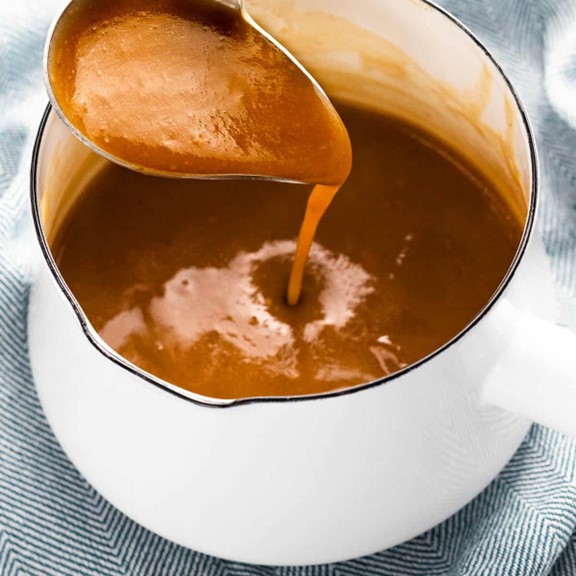
Understanding the process and learning the tricks of the trade will help you make perfect gravy every time. About.com has one of the best tutorials I’ve found on the subject, written by cookbook author, Peggy Trowbridge Filippone. Peggy says:
“First, determine the type of gravy you want. For a lighter touch, stick with simple pan gravy. If needing a heartier gravy to top a starch (mashed potatoes, rice or pasta), choose a thickened gravy.
“Simple Pan Gravy or Reduction Sauce: Most pan gravies are a simple reduction of the juices left in the pan after the food is cooked. A bit of wine or broth is added to the pan drippings, the cooked pieces from the pan’s bottom are scraped up and the liquid is allowed to cook down and thicken on its own. A dab of butter added at the end will increase flavor and give a glossy finish. It’s the easiest gravy to make—almost a no-fail.
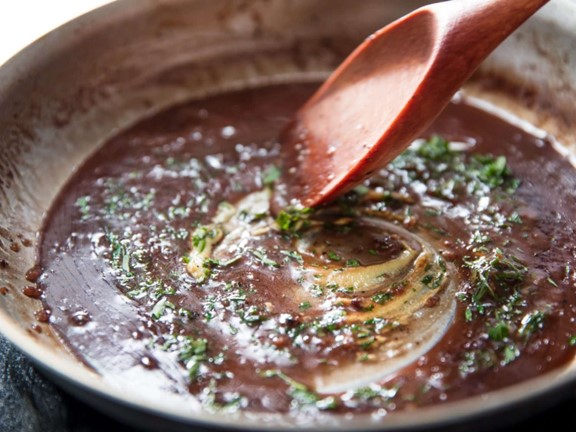
“Thickened Gravy: Popular gravy thickeners include flour, cornstarch, arrowroot, and dairy products. Methods differ for different thickeners, but they all basically begin with the simple pan gravy described above. It's difficult to give an exact recipe, since it will depend on the amount of seasoning on the meat and its fat content. Measurements needn’t be extremely precise as in baking. And that’s the good news—gravy-making becomes instinctual—you learn to judge by eye.”
Now for a few of Peggy’s gravy tips (which you might want to enter into a BEST Cooking Tips chapter you create in Cook’n):
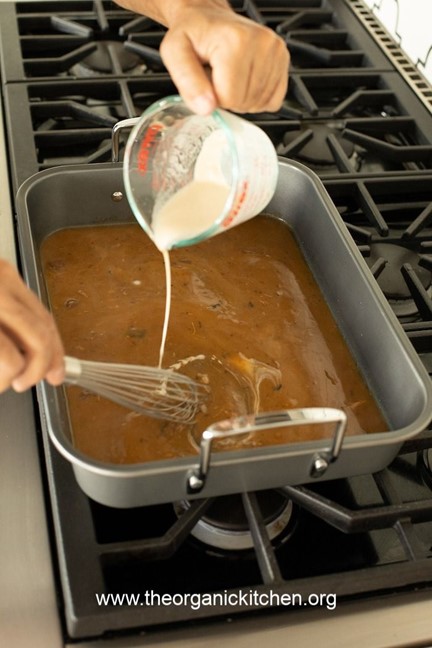
LUMPY GRAVY: Pour into blender and give it a whir for no more than thirty to sixty seconds. Don’t over-blend. Return to pot and reheat.
INSTANT MASHED POTATO FLAKES thicken well and produce no lumps. You may need extra salt, though.
TOO SALTY: Try adding a pinch or brown sugar or a 1/4 teaspoon vinegar.
USE FLOURS LOW IN PROTEIN and high in starch, such as cake flour, pastry flour or all-purpose flour. This will help prevent any "skin" from forming on gravy as it sits.
WHEN DEGLAZING THE PAN, be sure to scrape up those bits clinging to the bottom of the pan. They increase the flavor of the gravy and create an appealing texture.
CORNSTARCH has twice the thickening power of flour. ARROWROOT has slightly more than twice the thickening power of flour.
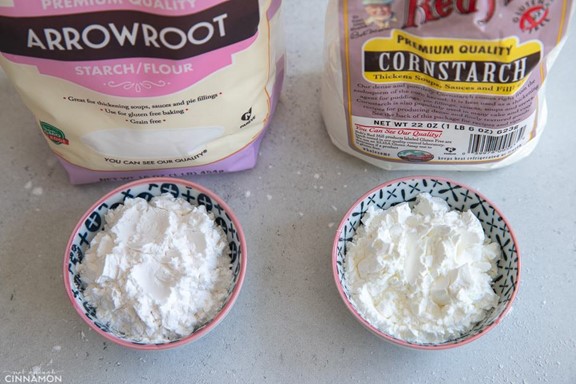
AVOID MAKING GRAVY in an aluminum (anodized is okay) pan as it can turn the gravy gray.
LIQUID GRAVY BROWNER can be added to gravy to improve color.
WHEN ADDING LIQUID TO A ROUX, add it slowly and whisk constantly to avoid lumping.
WHISKING A TABLESPOON of butter or heavy cream just before serving will give gravy a rich, satiny texture.
ADDING A TABLESPOON OF INSTANT COFFEE GRANULES or cocoa per two cups gravy enriches the flavor as well as adds color.
COOKED MEAT STORES AND FREEZES better in its gravy. The gravy keeps the meat from drying out.
I’ll close with a recipe we rely on for every holiday and Sunday dinner. www.thespruceeats.com is the originator and I thank those folks profusely for providing us with a truly no-fail route to the best gravy ever!
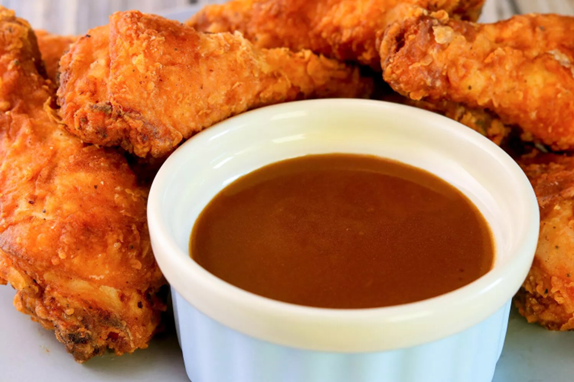
2 tablespoons meat or poultry drippings approximately
1 1/2 cups stock, wine, or water
1 tablespoon flour
1/4 cup water
salt to taste
2 tablespoons unsalted butter cold
Directions:
Add Recipe to Cook'n

Understanding the process and learning the tricks of the trade will help you make perfect gravy every time. About.com has one of the best tutorials I’ve found on the subject, written by cookbook author, Peggy Trowbridge Filippone. Peggy says:
“First, determine the type of gravy you want. For a lighter touch, stick with simple pan gravy. If needing a heartier gravy to top a starch (mashed potatoes, rice or pasta), choose a thickened gravy.
“Simple Pan Gravy or Reduction Sauce: Most pan gravies are a simple reduction of the juices left in the pan after the food is cooked. A bit of wine or broth is added to the pan drippings, the cooked pieces from the pan’s bottom are scraped up and the liquid is allowed to cook down and thicken on its own. A dab of butter added at the end will increase flavor and give a glossy finish. It’s the easiest gravy to make—almost a no-fail.

“Thickened Gravy: Popular gravy thickeners include flour, cornstarch, arrowroot, and dairy products. Methods differ for different thickeners, but they all basically begin with the simple pan gravy described above. It's difficult to give an exact recipe, since it will depend on the amount of seasoning on the meat and its fat content. Measurements needn’t be extremely precise as in baking. And that’s the good news—gravy-making becomes instinctual—you learn to judge by eye.”
Now for a few of Peggy’s gravy tips (which you might want to enter into a BEST Cooking Tips chapter you create in Cook’n):

LUMPY GRAVY: Pour into blender and give it a whir for no more than thirty to sixty seconds. Don’t over-blend. Return to pot and reheat.
INSTANT MASHED POTATO FLAKES thicken well and produce no lumps. You may need extra salt, though.
TOO SALTY: Try adding a pinch or brown sugar or a 1/4 teaspoon vinegar.
USE FLOURS LOW IN PROTEIN and high in starch, such as cake flour, pastry flour or all-purpose flour. This will help prevent any "skin" from forming on gravy as it sits.
WHEN DEGLAZING THE PAN, be sure to scrape up those bits clinging to the bottom of the pan. They increase the flavor of the gravy and create an appealing texture.
CORNSTARCH has twice the thickening power of flour. ARROWROOT has slightly more than twice the thickening power of flour.

AVOID MAKING GRAVY in an aluminum (anodized is okay) pan as it can turn the gravy gray.
LIQUID GRAVY BROWNER can be added to gravy to improve color.
WHEN ADDING LIQUID TO A ROUX, add it slowly and whisk constantly to avoid lumping.
WHISKING A TABLESPOON of butter or heavy cream just before serving will give gravy a rich, satiny texture.
ADDING A TABLESPOON OF INSTANT COFFEE GRANULES or cocoa per two cups gravy enriches the flavor as well as adds color.
COOKED MEAT STORES AND FREEZES better in its gravy. The gravy keeps the meat from drying out.
I’ll close with a recipe we rely on for every holiday and Sunday dinner. www.thespruceeats.com is the originator and I thank those folks profusely for providing us with a truly no-fail route to the best gravy ever!

Easy and Basic Pan Gravy
Yield: approximately 1 3/4 cups
Ingredients:
2 tablespoons meat or poultry drippings approximately
1 1/2 cups stock, wine, or water
1 tablespoon flour
1/4 cup water
salt to taste
2 tablespoons unsalted butter cold
Directions:
1. Gather the ingredients.
2. Keep the drippings in a saucepan on medium-high heat. If using pan drippings from a roast, place them in a saucepan with all the bits and pieces.
3. Add the stock, and with the help of a wooden spoon, stir well, removing all the bits and pieces that could be stuck to the bottom of the pan.
4. Bring the mixture to a boil, constantly scraping to loosen the drippings from the pan.
5. In a small bowl, combine 1/4 cup water with the flour and mix until smooth.
6. Stir the flour mixture into the pan and bring to a boil. Boil for about 5 minutes to reduce and thicken the sauce. Add salt to taste. Remove the pan from heat and whisk in the butter until you've achieved a homogenous silky gravy.
7. Enjoy on your favorite dishes.
2. Keep the drippings in a saucepan on medium-high heat. If using pan drippings from a roast, place them in a saucepan with all the bits and pieces.
3. Add the stock, and with the help of a wooden spoon, stir well, removing all the bits and pieces that could be stuck to the bottom of the pan.
4. Bring the mixture to a boil, constantly scraping to loosen the drippings from the pan.
5. In a small bowl, combine 1/4 cup water with the flour and mix until smooth.
6. Stir the flour mixture into the pan and bring to a boil. Boil for about 5 minutes to reduce and thicken the sauce. Add salt to taste. Remove the pan from heat and whisk in the butter until you've achieved a homogenous silky gravy.
7. Enjoy on your favorite dishes.
Recipe formatted with the Cook'n Recipe Software from DVO Enterprises.
 Alice Osborne
Alice Osborne
DVO Newsletter Contributor since 2006
Email the author! alice@dvo.com
Sources:
- www.drivemehungry.com
- www.seriouseats.com
- www.theorganickitchen.org
- www.notenoughcinnamon.com
- www.thespruceeats.com
